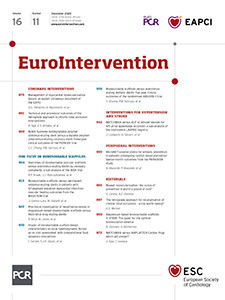
Left atrial appendage (LAA) closure has emerged as a feasible alternative to reduce thromboembolic events in patients with non-valvular atrial fibrillation (AF) who are at high risk of bleeding or contraindicated to oral anticoagulation (OAC). The WATCHMAN™ (Boston Scientific, Marlborough, MA, USA) is the most studied and the only endovascular device approved by the Food and Drug Administration (FDA), based on the PROTECT AF (WATCHMAN Left Atrial Appendage System for Embolic Protection in Patients with Atrial Fibrillation) and PREVAIL (Prospective Randomized Evaluation of the Watchman LAA Closure Device in Patients with Atrial Fibrillation versus Long Term Warfarin Therapy) trials that demonstrated non-inferiority of WATCHMAN compared to warfarin in reducing stroke and systemic embolisation1,2.
Outside the USA, the AMPLATZER™ Cardiac Plug (ACP) and its next-generation Amulet™ occluder (Abbott Vascular, Minneapolis, MN, USA) are approved and widely implanted in several countries. Several observational studies had shown favourable safety and efficacy of the ACP/Amulet compared with historical controls3. There are limited published comparative data between WATCHMAN and ACP/Amulet, with no randomised controlled trial (RCT) results available as yet. Currently, most operators choose commercially available devices based on operators’ and/or institutional experience and preference, and sometimes according to the anatomical features of the LAA.
Several small observational series comparing ACP/Amulet to WATCHMAN were summarised in a meta-analysis that included a total of 614 patients, showing comparative safety and efficacy of the two devices; however, the WATCHMAN had a higher incidence of peri-device leak (PDL) post implant4,5,6,7,8,9,10. In terms of RCTs comparing ACP/Amulet to WATCHMAN, the 1,878-patient AMPLATZER™ Amulet™ LAA Occluder Trial (Amulet IDE) has completed enrolment and results are anticipated in 2021, while the 200-patient Comparison of Amplatzer Amulet and Watchman Device in Patients Undergoing LAA Closure (SWISS-APERO) study is ongoing11,12.
In light of the relative lack of comparative data, Ledwoch et al conducted a direct comparison of the two devices by leveraging the prospective, multicentre LAARGE registry including 641 patients from 38 centres, published in this issue of EuroIntervention13.
Device choice was at the discretion of the operators/centres: 13 centres implanted only WATCHMAN, 17 centres implanted only ACP/Amulet, and the remaining eight implanted both devices. In the 278 (43%) patients treated with the WATCHMAN and 340 (53%) with the ACP/Amulet (177 ACP, 163 Amulet), the technical success rate was slightly lower with WATCHMAN (96% vs 99%, p=0.007). Major periprocedural complication rates were similar (3.6% WATCHMAN vs 4.7% ACP/Amulet, p=0.55), and the incidence of procedural PDL was not different between groups. The follow-up one-year composite of death or stroke, and the composite of death, stroke or systemic embolism, were also not significantly different between the groups. The median procedural time was longer with WATCHMAN (60 min vs 56 min, p=0.035), which may have been due to the higher proportion of patients undergoing general anaesthesia in the WATCHMAN group (15% vs 9%, p=0.021); the total fluoroscopy time was not different between the groups.
There were notable differences in terms of preprocedural imaging and LAA anatomy between the groups. More patients in the WATCHMAN group had preprocedural computed tomography (CT) performed (13% vs 1%, p<0.001), which may have been due to operator preference in WATCHMAN centres as opposed to anatomic/clinical concerns of more adverse anatomy. More patients in the WATCHMAN group had multi-lobed LAA (56% vs 38%, p<0.001), atypical anatomy (24% vs 6%, p<0.001), and were less likely to have chicken-wing anatomy (36% vs 55%, p<0.001). This reflects clinical practice, where shallow and sharp-bend chicken-wing LAAs, especially the retroflex type that bends superiorly and towards the right, are challenging for the WATCHMAN generation 2.5 device due to a much greater depth requirement compared to ACP/Amulet. Thus, LAA anatomy was a factor in device choice for operators in this study. Also, a much greater proportion of WATCHMAN patients were treated with larger devices that were ≥26 mm in size (59% WATCHMAN vs 28% ACP/Amulet). Although the actual LAA ostia measurements were not provided by the authors, it would appear that operators had oversized WATCHMAN devices to a greater degree than when implanting ACP/Amulet. This may explain why procedural PDL incidence was similar between the groups in this study, even though prior studies showed higher PDL with the WATCHMAN1,2,10.
This study provided a few clarifications and the authors should be commended for the analyses. First and foremost, procedural safety is similar for both devices. Technical success appears slightly better for the ACP/Amulet compared to the WATCHMAN generation 2.5 device used in this study, even with operators taking into consideration LAA anatomy for device selection. With optimal and greater oversizing, similar procedural PDLs can be achieved with the WATCHMAN. However, there is no follow-up imaging reported to assess long-term PDLs in this study and, since late PDLs can occur with LAA remodelling post closure, the question of comparative efficacy in appendage seal is not answered in this study. Likewise, there are no reported follow-up data on device-related thrombus (DRT), which is important for monitoring post-LAA closure since DRT can be associated with strokes. Nevertheless, the one-year death and thromboembolic rates were not different between the groups, which is reassuring. However, longer-term follow-up including device surveillance imaging is necessary to address the remaining issues of PDL, DRT, and durable clinical efficacy.
These data provide reassurance with the ACP/Amulet device in terms of technical success, procedural safety, and short-term to midterm efficacy. RCT data especially from the Amulet IDE study will provide definitive answers with regard to safety and longer-term efficacy in comparison to the WATCHMAN device. The next-generation WATCHMAN FLX™ device offers multiple technical advantages compared to the generation 2.5 device, including shorter device height, more nitinol struts (18 versus 10), double-row stabilising wires, larger device size (up to 35 mm), greater fabric device coverage, and a rounded distal end for safety. The WATCHMAN FLX recently received FDA approval (July 2020). Early clinical experience has been favourable: more challenging anatomy (including the shallow retroflex chicken-wing) can be treated with this new iteration. Indeed, the PINNACLE FLX prospective, multicentre, observational study (n=400) reported an implant success rate of 98.8% and procedural complication rate of only 0.5% with the WATCHMAN FLX device14. This improved technical success and safety achieved with the WATCHMAN FLX has raised the bar that the Amulet and other commercially available endovascular devices have to be compared to for market therapy dominance.
The answer as to which endovascular LAA closure device will prevail is still a moving target, as improved device iterations, novel features, and competitive devices continue to drive this innovative field forward to minimise procedural complications and maximise durable clinical efficacy in reducing thromboembolism with non-valvular AF.
Conflict of interest statement
J. Saw has received unrestricted research grant support (from the Canadian Institutes of Health Research, Heart & Stroke Foundation of Canada, National Institutes of Health, University of British Columbia Division of Cardiology, AstraZeneca, Abbott Vascular, St. Jude Medical, Boston Scientific, and Servier), salary support (Michael Smith Foundation of Health Research), speaker honoraria (AstraZeneca, Abbott Vascular, Boston Scientific, and Sunovion), consultancy and advisory board honoraria (AstraZeneca, St. Jude Medical, Abbott Vascular, Boston Scientific, Baylis, Gore, FEops), and proctorship honoraria (Abbott Vascular, St. Jude Medical and Boston Scientific). The other author has no conflicts of interest to declare.
Supplementary data
To read the full content of this article, please download the PDF.

